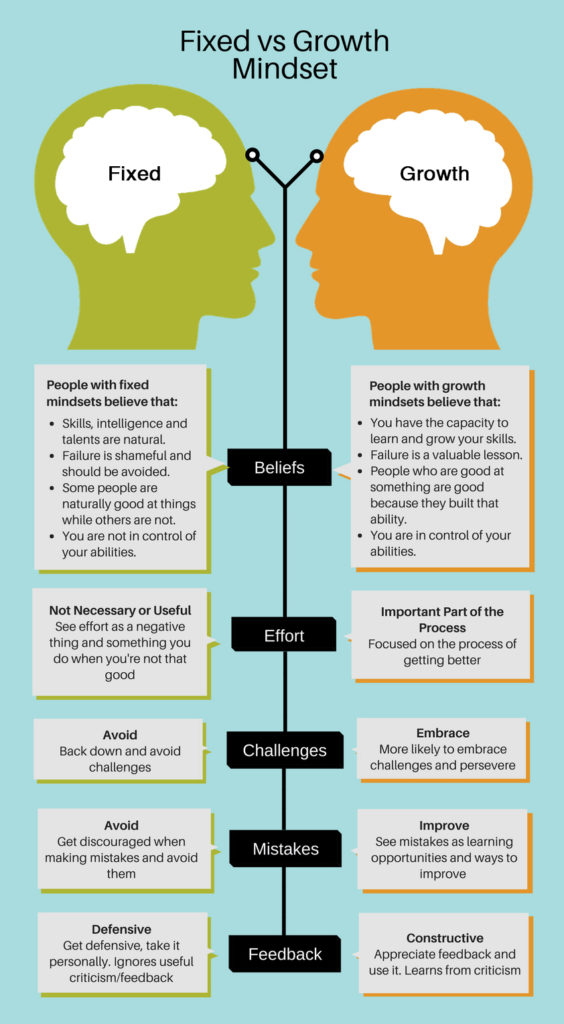
Our mindset determines our attitude. It’s the perceptual lens through which we see everything in our lives. As adults, we’re free to shape our minds in ways that serve our growth and purpose. A growth mindset is rooted in curiosity and positive anticipation. A fixed mindset, on the other hand, is based on fear and a sense of lack. By knowing the differences between a fixed vs growth mindset, you can transform your mindset into one that supports your growth and progress. (Estimated reading time 7 minutes)
“Dreams don’t work unless you do.”
— John C. Maxwell
“You’ll never be able to ____.”
“You’re not capable of ____!”
“What if you fail?”
These lines may sound familiar to you. Perhaps you heard them from a naysayer or a voice inside your head. No matter where it came from, you would have felt your inner light dim instantly.
Any situation that requires risk and pushes you outside your comfort zone (trying out for a team, applying for a higher job position, moving to another country, or asking someone out on a date) is when you’re most vulnerable.
When negative thoughts run through your mind, your body tenses up, your vision narrows, and all you see are the limitations and worst-case scenarios. The enthusiasm you felt prior to having those thoughts is drained out.
No one is immune to negative spells. All of us feel that way from time to time. Considering limitations and forecasting potential roadblocks is normal and even strategic, but we can’t get stuck in that mindset if we want to improve and move to the next level.
At some point, we must let go of our fixation on the bogeyman of our imagination. It’s at this crucial juncture that we must make the move from a fixed to a growth mindset. With a growth mindset, our thoughts become our allies, and we create a safe space in which to blossom. Knowing the difference between a fixed vs growth mindset can take us a step further.
Which wolf will you feed: understanding the duality in our thinking

A growth mindset is rooted in curiosity and positive anticipation. A fixed mindset, on the other hand, is based on fear and a sense of lack.
Together these two attitudes represent our dualistic nature. The side that dominates our thinking determines the stories we tell ourselves. The biggest challenge for most people is making a conscious choice to embrace the mindset that supports their growth.
There is a Native American parable where an old Cherokee chief teaches his grandson about life.
A fight is going on inside me," he told the young boy, "a fight between two wolves. One is Evil. It is anger, envy, jealousy, sorrow, regret, greed, arrogance, self-pity, guilt, resentment, inferiority, lies, false pride, superiority, and ego. The other is good. It is joy, peace, love, hope, serenity, humility, kindness, benevolence, empathy, generosity, truth, compassion and faith." He said, "My son, the battle is between two "wolves" inside us all.” The grandson thought about it for a minute and then asked his grandfather: "Which wolf wins?" The old Cherokee simply replied, "The one you feed."
When we feed the “evil” wolf, we feed our apathy, victimization, and cynicism. We weaponize those feelings as protection from putting ourselves out there. When we feed the “good” wolf, we remove the murkiness to see the possibilities and promise.
Before we can deal with the conflicts and tension in the outside world, we need to deal with the ones that are happening in our own heads. The wolf we choose to feed influences our actions, which ultimately shapes our destiny.
Fixed vs growth mindset: understanding their differences and origins

In recent years, modern psychology has supported the important role that our beliefs play when it comes to predicting our success.
Carol Dweck, a researcher at Stanford University, introduced these ideas in her book, “Mindset: The New Psychology of Success,” where she describes each mindset and the differences between a fixed vs growth mindset in detail.
In a fixed mindset, people believe their character, intelligence, and creative ability are fixed and cannot be changed. “They have a certain amount and that’s that, and then their goal becomes to look smart all the time and never look dumb,” Dweck writes.
Conversely, people with a growth mindset believe that their knowledge and intelligence can be developed through effort and persistence. They thrive on challenge and view failure as part of the process and use it as a catalyst for growth.
“They don’t necessarily think everyone’s the same or anyone can be Einstein, but they believe everyone can get smarter if they work at it,” she writes.
Why does our mindset matter? Because it determines our attitudes. It’s the perceptual lens through which we see everything in our life. No matter what information we take in, we’ll interpret it according to the beliefs we developed from our prior experiences and upbringing.
Our early years have a significant impact on whether our beliefs lean more towards a fixed or a growth mindset. Parents, friends, and teachers in school set the foundation for our approach.
They may have acted as cheerleaders who honed the expansive part of you, or they could have been your worst critics, minimizing your potential and convincing you to play small, either way, they will have had an impact.
Having an awareness of where your beliefs come from is the first step in transforming your mindset and gaining control over your outlook and responses to the world around you.
Focus on possibilities: creating a canvas for growth

As adults, we’re free to shape our minds in ways that serve our growth and purpose. While it may take more work for those whose childhood environments didn’t cultivate their strengths and curiosity, they can still transmute their thinking with awareness and practice.
In a speech for Harvard’s 2016 graduates, iconic film director Steven Spielberg highlighted the role our conscious mind and intuition play in making that shift, calling on the attendees to pay closer attention to the voice of encouragement inside their minds.
He said:
“I want to be clear that your intuition is different from your conscience. They work in tandem, but here’s the distinction: Your conscience shouts, ‘here’s what you should do,’ while your intuition whispers, ‘here’s what you could do.’ Listen to that voice that tells you what you could do. Nothing will define your character more than that.”
Often, it is the fearful voice of a fixed mindset that’s louder than the soft and encouraging whisper of our growth-oriented side. Spielberg modeled this throughout his life and career.
Despite struggling with dyslexia when he was a kid, dropping out of school, and consequently being rejected from film school at the University of Southern California School of Theater, he kept moving forward. Once he found his stride, he went on to make cinematic masterpieces such as E.T., Jaws and Saving Private Ryan.
His career trajectory is proof that when we focus on our limitlessness instead of our limitations, nothing is impossible, and we can truly create magic in our lives.
Transformation: change your life with a growth mindset

A growth mindset is not just a nice thing to have, it’s essential! It impacts every single facet of your life—from your success in both professional and personal contexts to your capacity for happiness and inner peace.
Learning and overcoming failures is hard enough. A fixed mindset only adds more resistance and makes things so much harder. A growth mindset, on the other hand, is like the tailwind of a plane, speeding up your progress.
As someone who grew up around individuals who made me more aware of what I couldn’t versus what I could do, I can attest to the power of a growth mind. I was told that I could never reach a certain dress size, that I wouldn’t make it to grad school, and that I was a loser who wouldn’t amount to anything even though I was hardworking and disciplined.
I never let their fixed views on my capabilities get to me. I was fortunate enough to have role models and books that protected the sanctity of my mind. While I’m not perfect and I still occasionally slip into a negative frame of mind, I’ve learned how to bounce back faster.
If you suspect that you have a fixed mindset that’s sabotaging your success and happiness, here are ten ways to help you transition into a growth mindset:
1. Get comfortable in your skin: Know who you are and what you stand for. Having a strong sense of identity means embracing both your strengths and imperfections. Know that your success is determined by effort and not solely by your talents.
2. Focus on progress, not perfection: Chasing perfection is a losing game. Instead, be driven by taking small, repeated actions that support your goals and celebrate the small wins along the way. Keep calm and take your time as your go through the learning curve.
3. View challenges as opportunities: Fear of failure and the unknown is one of the biggest blocks in developing a growth mindset. Begin seeing challenges as opportunities for growth and learning, and as stepping stones bringing you closer to your end goal.
4. Develop grit and focus: Grit is the ability to stick with what you’re doing no matter how tough things get. It gives you that internal push to keep moving forward and to persevere through obstacles. Keep your eye on the prize and let nothing distract you on your path.
5. Manage self-talk: Pay attention to your self-talk. Is it mostly critical and cruel? Or is it supportive and constructive? Every thought you have has an impact on how you feel about yourself and the actions you take. Replace negative thoughts with positive ones.
6. Find value in the process, not the result: When we allow ourselves to slow down and enjoy the journey, we’ll get comfortable with the steady pace of growth. It’s by going through the process that we develop character and inner resources that serve us in the long term.
7. Prioritize learning and novelty: Growth-minded people are constantly learning and finding ways to stimulate their minds. An active mind that isn’t afraid of making mistakes opens the doorway for improvement. Keep raising the bar and stepping outside your comfort zone so that you can stretch into new areas of growth,
8. Learn from others and seek feedback: Success leaves clues; that’s why learning from others can give you an advantage and lead to you making fewer mistakes. Be open to getting feedback from someone who can see what you’re doing from a different perspective and offer valuable suggestions.
9. Turn envy into curiosity: When we’re driven to succeed, we’re prone to comparing ourselves to others. If you find yourself envying someone else’s success, shift into a sense of curiosity. Try to figure out what they’re doing differently and what you can learn from them.
10. Be guided by a purpose: Growth is faster when it’s guided by a purpose. When you know your “big why” you’ll always find a way to make things happen. This intrinsic drive comes from our soul and not from the ego that focuses on petty competition. Let inspiration draw you in.
Your mind has infinite potential. However, it’s up to you to tap into this potential and make full use of it. You are the architect of your thoughts, and you have the ability to construct a mindset that serves you and your vision. Everything that you need to accomplish is within your reach.
All my best on your journey,
Seline

Question for you: Do you lean more towards a fixed or a growth mindset? Which differences standout out to you the most in a fixed vs growth mindset?
Did you like this post? Sign up below, and I’ll send you more awesome posts like this every week.

Thank you so much Seline.